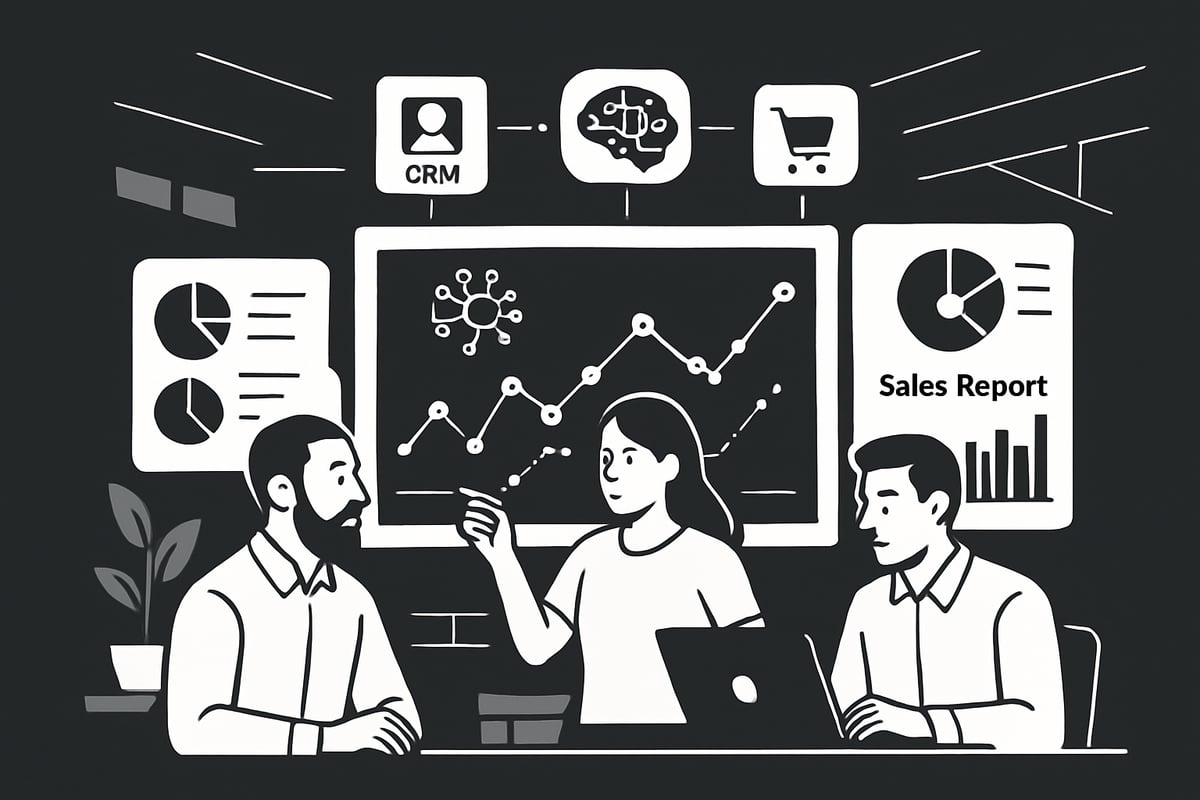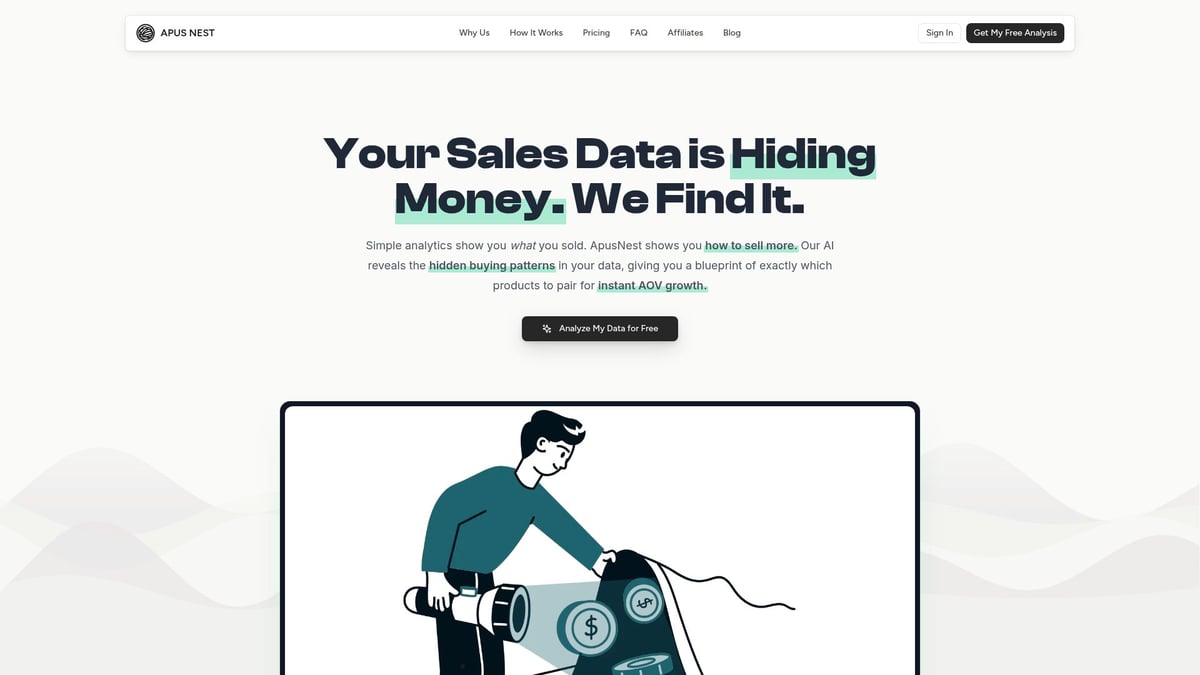In 2025, sales teams are navigating a landscape filled with complex data streams and rapidly changing buyer expectations. Making sense of this environment requires more than intuition—it demands a strategic sales analysis report that cuts through the noise and delivers actionable intelligence.
This article uncovers the seven essential insights every sales leader needs to extract from their sales analysis report to drive revenue growth and stay ahead of the competition. You will find practical guidance on sales performance, customer segmentation, pipeline health, win and loss trends, product mix, forecasting, and sales cycle optimization.
Are you ready to transform your approach and turn challenges into opportunities? Let’s dive in.
The Evolving Role of Sales Analysis Reports in 2025
The landscape of sales analysis report creation is quickly changing as businesses enter 2025. Sales teams now face massive volumes of data from CRM systems, e-commerce platforms, social media, and omnichannel interactions. Integrating these diverse sources is crucial, as it provides a holistic view of sales activities and customer behavior. For example, Salesforce’s 2024 State of Sales report reveals that 72% of teams rely on four or more data sources, highlighting the need for unified data. Real-time and predictive analytics are no longer optional; they are essential for modern reporting.

Modern Sales Data: Volume, Velocity, and Variety
Sales organizations must process not only more data, but also faster and from more varied sources. This results in a complex environment where sales analysis report accuracy depends on seamless data integration. Teams need to break down silos and ensure that every data touchpoint contributes to a complete picture. Real-time analytics empower leaders to spot trends as they emerge, rather than relying solely on historical reports.
Key Trends Influencing Sales Reporting
Artificial intelligence and automation are transforming the way sales analysis report findings are generated and interpreted. Customer-centric metrics like CLV and retention are prioritized, reflecting a shift toward understanding the full customer journey. With remote and hybrid sales teams, the methods of collecting and standardizing data have evolved. According to HubSpot, 57% of sales leaders now focus on customer journey analytics, driving more nuanced decision-making.
Common Challenges in Sales Analysis
Despite technological advances, challenges persist. Data silos, inconsistent reporting standards, and an overwhelming volume of KPIs can hinder effective sales analysis report development. It is critical to identify which metrics directly impact business objectives. Overcomplicating reports can lead to confusion, so clarity and relevance must remain top priorities. Aligning report content with strategic goals ensures insights are actionable rather than just informational.
The Strategic Value of Sales Insights
Transforming raw data into actionable insights can set organizations apart from competitors. A well-crafted sales analysis report provides not just numbers, but context and guidance for next steps. Gartner reports that companies leveraging advanced analysis achieved 19% higher revenue growth. These insights support agile decision-making, allowing businesses to anticipate market shifts and adjust strategies proactively.
What Makes a Sales Analysis Report “Essential” in 2025?
An essential sales analysis report in 2025 must be actionable, clear, and strategically aligned. Customization for different stakeholders—C-suite executives, managers, and reps—ensures relevance at every level. Integration with sales enablement and planning cycles is crucial for continuous improvement. For foundational strategies and expert advice, review Sales analysis best practices to ensure your reports drive real results.
7 Essential Sales Analysis Report Insights for 2025
In 2025, the sales analysis report is the backbone of strategic decision-making for revenue teams. With data volumes expanding and buyer behaviors shifting, leaders must focus on the right insights to drive growth and outpace competitors. Let’s break down the seven essential insights every sales leader should extract from their sales analysis report this year.

1. Comprehensive Sales Performance Metrics
A modern sales analysis report starts with a clear view of sales performance. This includes core metrics like revenue, sales volume, average deal size, and quota attainment. Tracking both lagging and leading indicators is essential for timely, data-driven decisions.
Key metrics to track in your sales analysis report:
| Metric | Description | Why It Matters |
|---|---|---|
| Revenue | Total sales generated | Measures business growth |
| Sales Volume | Number of deals closed | Tracks team productivity |
| Average Deal Size | Mean value of closed deals | Indicates sales effectiveness |
| Quota Attainment | % of goal achieved by reps | Assesses goal alignment |
Weekly reviews of these metrics reveal trends before they impact results. High-performing teams are 2.8 times more likely to review their sales analysis report weekly, according to HubSpot. This helps leaders detect early warning signs, such as declining deal size or missed quotas.
Benchmarking against industry peers gives context to your numbers. Visualizing results by rep, team, and region uncovers coaching opportunities. Automated dashboards ensure your sales analysis report is always up to date, freeing time for strategic action.
For practical examples of how these metrics look in action, review these Sales analysis report examples.
2. Advanced Customer Segmentation and Behavior Analysis
The next essential insight from a sales analysis report is customer segmentation. Segmenting your customer base by demographics, industry, lifecycle stage, and buying behavior reveals which groups drive revenue and which are at risk.
Using RFM (Recency, Frequency, Monetary) analysis, you can prioritize outreach and allocate resources efficiently. Your sales analysis report should highlight high-value segments, as well as those showing signs of churn.
AI-powered analytics can uncover hidden patterns in customer journeys that manual analysis might miss. For example, you might find that a specific industry segment responds best to certain messaging or products. Personalized sales approaches, driven by segmentation insights in your sales analysis report, have been shown by McKinsey to boost conversion rates by 40 percent.
Integrating these segmentation insights into your CRM streamlines workflows and empowers reps to act on data. List actionable tips in your sales analysis report to help teams tailor their outreach and improve win rates.
3. Pipeline Health and Opportunity Analysis
A healthy pipeline is vital for sales success. Your sales analysis report should provide visibility into key pipeline metrics, such as stage conversion rates, deal aging, and pipeline coverage. This allows leaders to spot bottlenecks and stalled deals before they threaten targets.
Funnel analysis within your sales analysis report pinpoints where leads are dropping off. By visualizing opportunity progression, you can identify stages that need attention. Regularly reviewing pipeline health helps forecast future revenue and supports more accurate planning.
Salesforce reports that 61 percent of sales leaders cite pipeline visibility as their top priority. Scheduling regular pipeline reviews based on your sales analysis report ensures actionable next steps are always clear for the team.
List actionable tips in your sales analysis report, such as focusing on deals stuck in later stages or opportunities with high potential but low engagement. This targeted approach increases the chances of successful closes and keeps your pipeline robust.
4. Win/Loss Analysis and Competitive Intelligence
Understanding why deals are won or lost is a powerful insight from any sales analysis report. Structured feedback from both reps and customers sheds light on patterns in sales outcomes.
Categorize loss reasons in your sales analysis report, such as pricing, product fit, timing, or competition. This clarity helps you address recurring objections and adapt your approach to market realities.
Competitive intelligence is another key element. By tracking competitor trends and common objections in your sales analysis report, you can proactively adjust sales strategies. Companies with formal win/loss programs see a 15 percent improvement in win rates, according to Capterra.
Feed these insights from your sales analysis report into sales enablement and product development efforts. This closes the loop between frontline feedback and strategic initiatives, driving continuous improvement across the organization.
5. Product and Service Mix Performance
A robust sales analysis report delivers deep insights into your product and service mix. Tracking sales by product, SKU, or service line identifies top performers and those needing attention.
Analyze cross-sell and upsell opportunities using basket analysis within your sales analysis report. For instance, you might discover certain products are frequently purchased together, indicating potential for bundled promotions.
A well-structured sales analysis report helps adjust inventory and marketing based on real-time product trends. Shopify Plus reports that optimizing product mix can boost average order value by 20 percent.
Use product performance data in your sales analysis report to inform bundling strategies and time-limited promotions. This data-driven approach maximizes both revenue and customer satisfaction.
6. Sales Forecasting Accuracy and Predictive Insights
Your sales analysis report should compare forecasted versus actual sales to highlight gaps and opportunities. By leveraging AI and machine learning, you can generate predictive analytics that improve forecast accuracy.
Historical data in your sales analysis report can reveal seasonal patterns and campaign impacts. Real-time data feeds ensure forecasts remain current, reducing the risk of surprises.
Gartner found that accurate forecasting correlates with a 10 percent increase in revenue attainment. Regularly updating your forecasting models based on your sales analysis report keeps your strategy agile and responsive.
Include actionable recommendations in your sales analysis report, such as adjusting targets for emerging trends or reallocating resources to high-potential segments. This keeps your forecasts relevant and achievable.
7. Sales Cycle and Process Optimization
The final essential insight is sales cycle and process optimization. Your sales analysis report should measure cycle length by deal type, segment, and rep, highlighting inefficiencies.
Identify process bottlenecks using your sales analysis report, such as steps that add unnecessary time or reduce conversion rates. Automating manual tasks, as revealed in your sales analysis report, can significantly shorten cycles.
Correlate sales activities like calls and demos with deal progression in your sales analysis report. HubSpot found that teams optimizing their sales processes close 18 percent more deals.
Implement continuous reviews and A/B testing based on your sales analysis report findings. This ensures your sales process evolves with changing buyer expectations and market conditions.
Integrating AI-Powered Market Basket Analysis for Deeper Product Insights
Unlocking deeper insights from your sales analysis report requires more than just tracking top sellers. To truly understand what drives customer purchases, modern teams are turning to AI-powered market basket analysis. This advanced approach uncovers patterns that traditional reporting often misses, transforming how businesses view product relationships and customer buying behavior.
How Market Basket Analysis Transforms Sales Reporting
Market basket analysis goes beyond simple sales numbers in a sales analysis report. It examines transaction-level data to reveal which products customers frequently buy together, exposing hidden affinities and cross-sell opportunities. For example, if data shows customers who purchase noise-cancelling headphones often add travel adapters, your team can craft targeted bundles or promotions.

This method is particularly powerful for e-commerce and omnichannel retailers. By leveraging AI, market basket analysis processes large volumes of data from platforms like Shopify or WooCommerce, identifying product pairings that boost average order value (AOV). ApusNest enables businesses to access these insights effortlessly, providing non-technical users with actionable recommendations based on real purchase patterns.
| Benefit | Description |
|---|---|
| Product Pairing Discovery | Identifies high-value product combinations |
| Targeted Cross-Sell Strategies | Recommends relevant add-ons or bundles |
| Inventory Optimization | Informs stock planning based on purchasing data |
| Marketing Effectiveness | Guides campaigns with data-driven insights |
With a projected 51.7x ROI from a single report, AI-powered market basket analysis is a game changer. It not only strengthens your sales analysis report but also guides inventory, marketing, and merchandising strategies. For a deeper dive into maximizing product performance, explore product mix performance analysis to see how these insights can be further applied.
Integrating market basket analysis into your sales analysis report empowers your team to anticipate customer needs and maximize every transaction. By highlighting product associations and streamlining decision-making, this approach ensures your sales analysis report supports data-driven growth in 2025.
Best Practices for Actionable Sales Analysis Reporting in 2025
Building an effective sales analysis report in 2025 means more than collecting numbers. It requires a strategic approach to data, visualization, customization, and ongoing improvement. Let’s explore the essential best practices that transform raw data into meaningful, actionable business intelligence.

Data Quality and Integration
Data quality is the bedrock of any sales analysis report. Unified, accurate data from all sales channels ensures that reports reflect reality, not guesswork. Integrating CRM, e-commerce, and marketing platforms provides a holistic view of sales performance. Regular data audits help eliminate duplicates and fill information gaps. According to Gartner's Future of Sales 2025 Report, organizations prioritizing robust data integration are better positioned to adapt to rapid market changes. A clean data foundation empowers timely, trusted insights.
Visualization and Storytelling
Effective sales analysis reporting relies on clear visualization. Dashboards, heatmaps, and trend lines transform raw figures into stories that drive action. Well-designed visuals spotlight urgent opportunities and emerging risks. Storytelling with data makes complex trends accessible to all stakeholders. Using visual cues, such as color coding and annotations, helps teams quickly interpret findings and prioritize next steps. An engaging, visual sales analysis report enables faster, smarter decision-making across your organization.
Customization for Stakeholders
Every audience needs something different from a sales analysis report. Executives want high-level summaries and forecasts, while managers and reps need actionable details. Customizing reports by role ensures everyone gets relevant insights without information overload. For example, a granular performance breakdown supports coaching, while an executive summary guides strategic planning. Tailored reporting increases engagement and helps each team member act on what matters most to them.
Embedding Insights into Daily Workflows
A sales analysis report is only valuable if it drives action. Embedding insights into daily workflows—through automated alerts, CRM integrations, or scheduled reports—ensures timely responses to trends and anomalies. Setting up triggers for follow-up tasks based on report findings helps teams stay proactive. Integrating these insights into sales enablement tools creates a seamless feedback loop between analysis and execution, making data-driven decisions part of everyday operations.
Continuous Improvement and Feedback Loops
The most effective sales analysis report evolves with your business. Gather feedback from users to refine report formats and content. Regularly review KPIs and adjust report structures based on changing objectives. Monthly reviews ensure alignment with business goals and allow for rapid response to market shifts. Embracing a culture of continuous improvement positions your reporting strategy to stay relevant and effective in 2025.
Security, Privacy, and Compliance
Protecting sales data is non-negotiable. All reporting processes must comply with regulations like GDPR and CCPA. Secure data handling practices—such as access controls and encryption—reduce risk and build trust. Ensuring compliance not only prevents legal issues but also demonstrates a commitment to ethical data stewardship. Regular audits verify that your sales analysis report processes meet evolving standards.
Training and Enablement
Empowering your team to interpret and act on sales analysis report findings is crucial. Provide training through workshops, guides, and interactive sessions. Building data literacy ensures that everyone—from reps to executives—can leverage insights effectively. Well-trained teams maximize the value of your sales analysis report, turning data into a true driver of growth and competitive advantage.